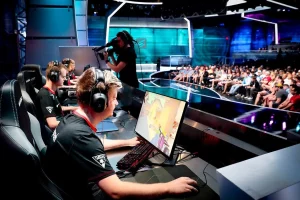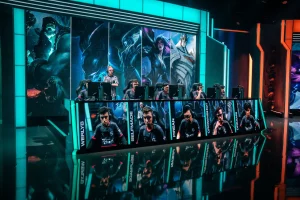Introduction
The term “Esports” refers to organized, competitive video gaming, where professional players and teams compete in various games for prizes, sponsorships, and glory. The rise of esports has been meteoric, with millions of fans tuning in to watch live events, streaming platforms, and even traditional television broadcasts. As we look to the future of competitive gaming, several key factors are poised to shape its trajectory.
The Growth of Esports

1.Market Expansion
The esports market has seen exponential growth, with revenues projected to surpass $1.5 billion by 2023. This growth is driven by several factors, including increased investment from traditional sports teams, media companies, and sponsors. The future of competitive gaming will likely see continued market expansion, with new revenue streams emerging from merchandise sales, ticket sales for live events, and digital content.
2.Audience Engagement
One of the most significant drivers of esports’ growth is its ability to engage a diverse and global audience. Platforms like Twitch, YouTube Gaming, and Facebook Gaming have made it easier than ever for fans to watch and interact with their favorite players and teams. The future of competitive gaming will likely see even more sophisticated methods of audience engagement, such as virtual reality (VR) experiences and augmented reality (AR) overlays during live broadcasts.
Technological Advancements

1.Improved Hardware and Software
The future of competitive gaming will be heavily influenced by advancements in hardware and software. High-performance gaming PCs, consoles, and peripherals are becoming more accessible, enabling a broader range of players to compete at a high level. Additionally, game developers are continually improving the quality and complexity of esports titles, providing more immersive and challenging experiences for players and spectators alike.
2.Artificial Intelligence and Machine Learning
Artificial intelligence (AI) and machine learning (ML) are set to revolutionize competitive gaming. AI-driven analytics can provide players with insights into their performance, helping them to refine their strategies and improve their skills. Moreover, AI can be used to create more sophisticated in-game opponents, offering players a higher level of competition. The future of competitive gaming will likely see AI and ML playing an increasingly central role in both player development and game design.
The Role of Traditional Sports Organizations

1.Investment and Partnerships
Traditional sports organizations have recognized the potential of esports and are increasingly investing in the industry. Many professional sports teams have established their own esports divisions, while others have formed partnerships with existing esports organizations. This trend is expected to continue, with traditional sports organizations bringing their expertise in marketing, sponsorship, and event management to the esports arena.
2.Cross-Promotional Opportunities
The future of competitive gaming will likely see more cross-promotional opportunities between traditional sports and esports. For example, esports events could be held in conjunction with major sporting events, providing fans with a diverse and exciting entertainment experience. Additionally, traditional sports stars may become more involved in esports, either as players, team owners, or brand ambassadors.
Emerging Trends

1.Mobile Esports
Mobile gaming has become a significant segment of the gaming industry, and mobile esports is following suit. Games like “PUBG Mobile,” “Free Fire,” and “Clash Royale” have garnered massive followings and competitive scenes. The future of competitive gaming will likely see mobile esports gaining even more prominence, driven by the increasing power and accessibility of smartphones.
2.Collegiate and Amateur Esports
As esports continues to grow, there is a rising interest in collegiate and amateur competitive gaming. Universities and colleges are establishing esports programs, offering scholarships, and hosting tournaments. This trend is expected to expand, providing a pipeline of talent for professional teams and fostering a broader competitive gaming ecosystem.
Challenges and Considerations

1.Regulation and Governance
As the esports industry grows, there will be an increasing need for regulation and governance. Issues such as player contracts, match-fixing, and doping need to be addressed to ensure the integrity of the competition. The future of competitive gaming will likely see the establishment of more robust regulatory frameworks, potentially overseen by international governing bodies.
2.Mental Health and Well-being
The intense nature of competitive gaming can take a toll on players’ mental health and well-being. Long hours of practice, the pressure to perform, and the scrutiny of fans can lead to burnout and other mental health issues. The future of competitive gaming will need to prioritize the well-being of players, with organizations implementing support systems and promoting a healthy work-life balance.
Conclusion
The future of competitive gaming is bright, with numerous opportunities for growth and innovation. As technology advances, the market expands, and new trends emerge, esports is poised to become an even more integral part of the global entertainment landscape. However, the industry must also navigate challenges related to regulation, governance, and player well-being to ensure a sustainable and thriving future for competitive gaming.
In summary, the future of competitive gaming promises to be an exciting journey, marked by technological advancements, increased investment, and a growing, engaged audience. As we look ahead, it is clear that esports will continue to evolve and captivate fans around the world, solidifying its place as a cornerstone of modern entertainment.




